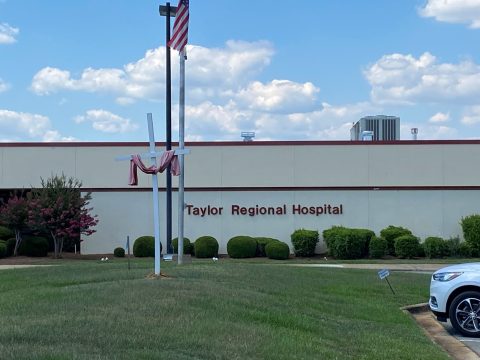This is Part 3 of a Special Report
Madelaine Austin is having her first baby, and had planned to give birth at Stephens County Hospital in northeast Georgia, just five minutes from her home.
But in the middle of her pregnancy, she was forced to change OB/GYNs and the facility where she would deliver her child.

The Toccoa resident, 19, was recently told that Stephens County Hospital, dealing with financial deficits, was suspending its labor and delivery service due to costs.
“I never expected this,’’ Austin said. Her former OB/GYN, she said, “made me feel very confident and comfortable.’’ She’ll now have her baby at a hospital 25 to 30 minutes away.

The Toccoa hospital emphasizes that its closure of labor and delivery services is not necessarily permanent. Still, there have been 40 Georgia hospitals that have shut down their labor and delivery units in recent years.
Such a move leads to the departure of OB/GYNs from the area where a hospital is located – all of which creates challenges for many women still living there. They have to travel farther for prenatal care, and if they are in labor, they have to travel farther to deliver.
“If a woman has to travel more than 40 miles, her chances of preterm labor, preterm birth and obstetrical complications are three times higher,’’ said Dr. Hugh Smith, a retired Thomaston OB/GYN.
The erosion of obstetrical services is occurring nationally as well. The percentage of rural counties with available hospital-based obstetrical services dropped from 55% to 46% between 2004 and 2014, according to a study in the Journal of the American Medical Association.
The loss of hospital-based services is associated with increases in out-of-hospital and preterm births, and births in hospitals without obstetric units, said the research program.
In Georgia, 93 of the 159 counties in the state have no hospital with a labor and delivery unit.

Last year, with financial losses piling up, Taylor Regional Hospital in central Georgia shut down its labor and delivery unit because “we weren’t delivering enough babies to make it viable,’’ said Richard Stokes, its chief financial officer.
The rural Hawkinsville hospital did roughly 230 births a year. But it takes about 350 to break even on the service, said Jimmy Lewis, CEO of HomeTown Health, an association of rural hospitals in the state.

The nearest birthing hospital is now about 25 minutes away from Hawkinsville.
Hospitals that are barely surviving financially can lose up to $1 million on labor and delivery, Lewis said. But they are reluctant to give up obstetrics, he said, because “there’s so much emotion involved.’’
“It rips the heart out of the community’’ to give up births, Lewis said. And for women who are pregnant or contemplating having a baby, “it creates fear and anxiety.’’
Transportation thus becomes crucial. But many low-income women in rural areas don’t have a car. And others who have low incomes tend to skip appointments, Smith said. They’re going be sure they can feed their families before they think about taking off work to go to prenatal appointments, he said.

So with the OB unit closures, “we have a general access-to-care issue,’’ said Jacob Warren, director of the Center for Rural Health and Health Disparities at Mercer University School of Medicine. “Two-thirds of rural births come outside the family’s home county.’’
A report by Surgo Ventures, citing a 2019 study, said that rural residents have a 9 percent greater probability of severe maternal morbidity and mortality than those in urban areas. Georgia has one of the highest rates of maternal mortality, defined as deaths due to complications from pregnancy or childbirth.
Rural women in Georgia have a significantly higher maternal mortality rate than those in urban Georgia, Warren said. And rural African-American women have double the maternal mortality rate of rural White women.
Warren said no rural county in Georgia has a maternal-fetal medicine specialist — a doctor who helps take care of women having complicated or high-risk pregnancies. And a long ambulance ride to a distant hospital can lead to bad medical outcomes.
The state created a review panel in 2014 to identify maternal deaths and their causes. Approximately 26 Georgia women die from pregnancy complications for every 100,000 live births, compared to the national average of about 17 women. And about 60% of the state’s maternal deaths between 2012 and 2016 were found to be preventable.
Key factors in many of these cases are high levels of chronic disease, such as hypertension and diabetes, along with high levels of poverty and low levels of people with health insurance. Georgia has the third-highest uninsured rate in the country.
Some of the same factors lead to the state’s high infant mortality rate. “The counties with the highest infant mortality rates in Georgia are all rural,’’ Warren said. A lack of prenatal care raises the risk of preterm birth and infant mortality.

Many pregnant women in rural areas don’t get this care. “If they have to drive an hour, they don’t have the ability to leave work,’’ said Dr. Justin Peterson, an OB/GYN in Douglas in Coffee County. “I have a lot of patients who are very high-risk. I have to spend more time with these patients.’’
The lack of prenatal care also can raise the risk of maternal death, Warren said.
Georgia has recently been focusing on these issues. For one thing, it has increased Medicaid coverage for new moms to six months, up from two months.
“That’s a hugely impactful decision.’’ Warren said.
That Medicaid coverage would be extended to 12 months post-partum for all states, under the social spending bill being debated in Congress.
The Arthur M. Blank Family Foundation contributed funding for the reporting of this article.
Read Part 1: A rural Georgia community reels after hospital closes
Read Part 2: How rural health care ‘limps along’ in certain communities

